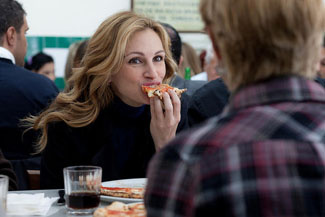Book vs. Movie: Eat Pray Love
By Russ Bickerstaff
August 18, 2010
In this corner: the Book. A collection of words that represent ideas when filtered through the lexical systems in a human brain. From clay tablets to bound collections of wood pulp to units of stored data, the book has been around in one format or another for some 3,800 years.
And in this corner: the Movie. A 112-year-old kid born in France to a guy named Lumiere and raised primarily in Hollywood by his uncle Charlie "the Tramp" Chaplin. This young upstart has quickly made a huge impact on society, rapidly becoming the most financially lucrative form of storytelling in the modern world.
Both square off in the ring again as Box Office Prophets presents another round of Book vs. Movie.
Eat, Pray Love
At the beginning of this past decade, wealthy journalist and author Elizabeth Gilbert was having a difficult time. As it turned out, she did not in fact, want to have the child she was so desperately trying to have with her husband. So she split-up with him, got a book deal, quit her job with a national magazine and traveled to three different countries to try to find herself. The resulting book was picked-up by the Oprah Book Club and promptly became a best-seller, which has now been turned into a Columbia Pictures film starring Julia Roberts as poor rich girl Elizabeth Gilbert. How does the fictionalized film compare with best-selling autobiographical work that it’s based on?
The Book
Autobiographical works are only as charming as their authors. Being a wealthy and successful author with a reasonably interesting life that seems pretty far removed from day to day realities, it’s kind of difficult to identify with Gilbert in Eat, Pray, Love: One Woman's Search for Everything Across Italy, India and Indonesia. That being said, a great many people have felt a strong enough connection with the charm of its author to make the book a huge success. And it goes without saying that a great many people don’t find Gilbert to be all that charming. We don’t often hear that much from these people, as they are more likely to dismiss the book as an exercise in the author’s hubris. It is in the interest of giving written form to this perspective that I have decided to embark on an analysis of a book that I ordinarily wouldn’t have read. I hope to turn it into a 300 page manuscript entitled Eat, Love, Whatever: One Man’s Struggle to Understand a Culturally Beloved Book That He Doesn’t Give A Damn About. I’m hoping to submit it to Penguin Books by the end of the summer.
The book opens instantly in stunningly adequate first-person prose. Elizabeth Gilbert is unhappy. She suffers from depression, a very serious disorder that doesn’t necessarily do a whole lot to make her likeable. The fact that she’s suffering only makes her human. People can be depressed and be charming or suffer from depression and still come across as self-absorbed assholes. Gilbert proceeds to go on at some length about the fact that her relationship with her husband had been falling apart. She does so without going into specifics, which is fine. She sites the fact that the break-up is personal and also says that she couldn’t be objective about her own divorce, which is also fine. The problem with this is that she goes into a degree of detail about the actual divorce process over the course of the book, which paints her ex-husband in an unflattering light and causes her to come across as petty and juvenile. If you’re going to be traveling to three different countries with an author within her own first-person narrative, you really don’t want to feel as though your narrative guide is petty and childish. It ends up feeling like a very, very long journey…
Continued:
1
2
3




